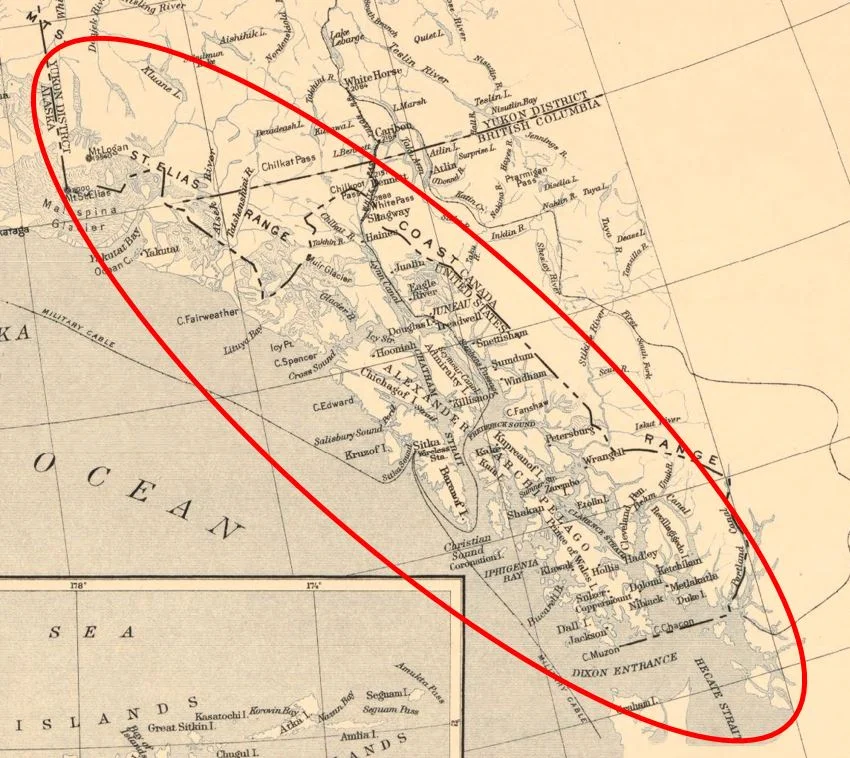Extremely Rare Antique Teddy Roosevelt Bandanna | Made to Celebrate America's Victory in the Alaska Boundary Dispute | Circa 1907
Extremely Rare Antique Teddy Roosevelt Bandanna | Made to Celebrate America's Victory in the Alaska Boundary Dispute | Circa 1907
Frame Size (H x L): 32” x 33”
Bandanna Size (H x L): 22” x 23”
Offered is a rare lithographed bandanna associated with Teddy Roosevelt and the Alaska Boundary Dispute. It is made of linen, and was copyrighted in 1907 by Schwab & Co. of New York.
The image features two bears depicted as hunters carrying a dead lynx on a stick. The bears represent the United States and Roosevelt, while the lynx represents Canada and its failure to successfully argue its position in the Boundary Dispute. The bear on the left side has a blue bandanna around his neck, a cartridge belt around his waist, and a satchel over his shoulder. The satchel includes an overprint that says “Washington, D.C.” The bear on the right side has a red bandanna around his neck, a cartridge belt around his waist, and a rifle on his arm. He is also wearing a Roosevelt style pair of glasses and hat. The hat includes an overprint that says “I Did It,” in reference to Roosevelt’s strong stance and success in the Boundary Dispute.
Prior to 1900, the boundary of Southeastern Alaska and the coast of British Columbia (as shown in the images) was poorly defined, particularly in the contested area, referred to as the Alaska Panhandle. For decades, neither the US nor Canada made a strong claim to this area, as it was rugged wilderness and of little value. This changed, however, when gold was discovered in the Klondike. With this discovery, Canada wanted clear ownership of the Alaska Panhandle, and a direct route from the Klondike gold fields to the Pacific fjords. Likewise, the US wanted clear ownership.
In 1903, the controversy was referred to an international tribunal, comprising three American politicians, two Canadian politicians, and Lord Alverstone of England. The tribunal reviewed the 1825 Treaty of Saint Petersburg, and particularly its declaration that the border, at issue, shall lie 56 km east of the ocean coast. Because the coast, near the contested area, is so fragmented by the ocean fjords, the US argued that the ocean coast be defined relatively eastwards, while Canada argued the opposite. As expected, the three American politicians favored the American position, and the two Canadian politicians favored the Canadian position. Lord Alverstone favored the American position, and provided the necessary majority vote. Canada viewed this as a betrayal by its colonial government, and refused to sign the final decision. Despite this protest, the tribunal’s decision was binding on the parties and Roosevelt received significant praise in the US.
This bandanna is not document in the Threads of History, written by Herbert Ridgeway Collins. Mr. Collins was the curator of the Division of Political History at the Smithsonian Institute. His book is the best reference available for political textile collectors and includes over fifteen-hundred examples, dating from 1775 to 1979. In writing his book, Mr. Collins sent thousands of letters to collectors, museums, and universities, and requested their assistance in his quest to document every known political textile. Despite his efforts, as noted above, this bandanna is not documented therein, which points to the rarity of this textile.
Conservation Process: This bandanna was hand sewn to cotton fabric, and both were hand sewn to a mounting board. To prevent the black dye in the cotton fabric from seeping into the bandanna, it was first washed in a standard wash and then in a dye setting wash. The bandanna is positioned behind Optium Museum Acrylic.
Frame: This offering is in our Large Black and Gold Frame.
Condition Report: This bandanna has minor stains throughout its surface. In particular, there are stains above and below the bear that is on the right side of the bandanna. Additionally, this bandanna exhibits some fading throughout its surface. Despite these flaws, however, this rare bandanna presents very well and is a statement piece.
Collectability Level: The Great – Perfect for Rising Collectors
Date of Origin: 1907




